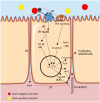Feed, Microbiota, and Gut Immunity: Using the Zebrafish Model to Understand Fish Health
- PMID: 32117265
- PMCID: PMC7014991
- DOI: 10.3389/fimmu.2020.00114
Feed, Microbiota, and Gut Immunity: Using the Zebrafish Model to Understand Fish Health
Abstract
Aquafeed companies aim to provide solutions to the various challenges related to nutrition and health in aquaculture. Solutions to promote feed efficiency and growth, as well as improving the fish health or protect the fish gut from inflammation may include dietary additives such as prebiotics and probiotics. The general assumption is that feed additives can alter the fish microbiota which, in turn, interacts with the host immune system. However, the exact mechanisms by which feed influences host-microbe-immune interactions in fish still remain largely unexplored. Zebrafish rapidly have become a well-recognized animal model to study host-microbe-immune interactions because of the diverse set of research tools available for these small cyprinids. Genome editing technologies can create specific gene-deficient zebrafish that may contribute to our understanding of immune functions. Zebrafish larvae are optically transparent, which allows for in vivo imaging of specific (immune) cell populations in whole transgenic organisms. Germ-free individuals can be reared to study host-microbe interactions. Altogether, these unique zebrafish features may help shed light on the mechanisms by which feed influences host-microbe-immune interactions and ultimately fish health. In this review, we first describe the anatomy and function of the zebrafish gut: the main surface where feed influences host-microbe-immune interactions. Then, we further describe what is currently known about the molecular pathways that underlie this interaction in the zebrafish gut. Finally, we summarize and critically review most of the recent research on prebiotics and probiotics in relation to alterations of zebrafish microbiota and immune responses. We discuss the advantages and disadvantages of the zebrafish as an animal model for other fish species to study feed effects on host-microbe-immune interactions.
Keywords: gut; immunity; intestine; microbiota; prebiotics; probiotics; zebrafish.
Copyright © 2020 López Nadal, Ikeda-Ohtsubo, Sipkema, Peggs, McGurk, Forlenza, Wiegertjes and Brugman.
Figures


Similar articles
-
Use of a paraprobiotic and postbiotic feed supplement (HWF™) improves the growth performance, composition and function of gut microbiota in hybrid sturgeon (Acipenser baerii x Acipenser schrenckii).Fish Shellfish Immunol. 2020 Sep;104:36-45. doi: 10.1016/j.fsi.2020.05.054. Epub 2020 May 27. Fish Shellfish Immunol. 2020. PMID: 32473360
-
Connecting the immune system, systemic chronic inflammation and the gut microbiome: The role of sex.J Autoimmun. 2018 Aug;92:12-34. doi: 10.1016/j.jaut.2018.05.008. Epub 2018 Jun 1. J Autoimmun. 2018. PMID: 29861127 Review.
-
Microbiota plasticity in tilapia gut revealed by meta-analysis evaluating the effect of probiotics, prebiotics, and biofloc.PeerJ. 2023 Oct 11;11:e16213. doi: 10.7717/peerj.16213. eCollection 2023. PeerJ. 2023. PMID: 37842054 Free PMC article.
-
Diet effects in gut microbiome and obesity.J Food Sci. 2014 Apr;79(4):R442-51. doi: 10.1111/1750-3841.12397. Epub 2014 Mar 12. J Food Sci. 2014. PMID: 24621052 Review.
-
Comparative immunostimulatory effect of probiotics and prebiotics in Channa punctatus against Aphanomyces invadans.Fish Shellfish Immunol. 2019 Mar;86:965-973. doi: 10.1016/j.fsi.2018.12.051. Epub 2018 Dec 25. Fish Shellfish Immunol. 2019. PMID: 30590159
Cited by
-
Intestinal Transcriptome Analysis Reveals Enrichment of Genes Associated with Immune and Lipid Mechanisms, Favoring Soybean Meal Tolerance in High-Growth Zebrafish (Danio Rerio).Genes (Basel). 2021 May 8;12(5):700. doi: 10.3390/genes12050700. Genes (Basel). 2021. PMID: 34066767 Free PMC article.
-
Modulation of gut microbiota composition and predicted metabolic capacity after nutritional programming with a plant-rich diet in Atlantic salmon (Salmo salar): insights across developmental stages.Anim Microbiome. 2024 Jul 1;6(1):38. doi: 10.1186/s42523-024-00321-8. Anim Microbiome. 2024. PMID: 38951941 Free PMC article.
-
Multi-dimensional investigation and distribution characteristics analysis of gut microbiota of different marine fish in Fujian Province of China.Front Microbiol. 2022 Sep 27;13:918191. doi: 10.3389/fmicb.2022.918191. eCollection 2022. Front Microbiol. 2022. PMID: 36238589 Free PMC article.
-
Dietary Supplementation with a Blend of Hydrolyzable and Condensed Tannins Ameliorates Diet-Induced Intestinal Inflammation in Zebrafish (Danio rerio).Animals (Basel). 2022 Dec 31;13(1):167. doi: 10.3390/ani13010167. Animals (Basel). 2022. PMID: 36611775 Free PMC article.
-
Dietary supplementation with microalgae enhances the zebrafish growth performance by modulating immune status and gut microbiota.Appl Microbiol Biotechnol. 2022 Jan;106(2):773-788. doi: 10.1007/s00253-021-11751-8. Epub 2022 Jan 6. Appl Microbiol Biotechnol. 2022. PMID: 34989826
References
Publication types
MeSH terms
Substances
LinkOut - more resources
Full Text Sources

